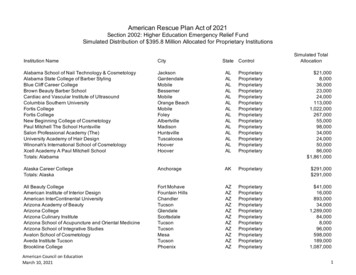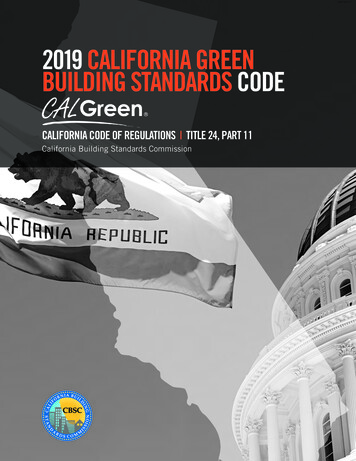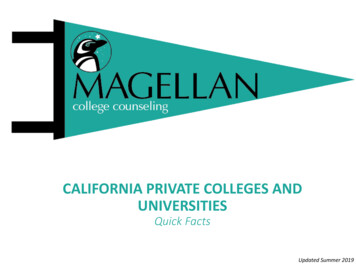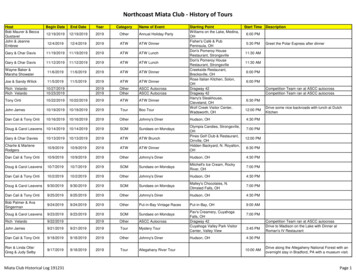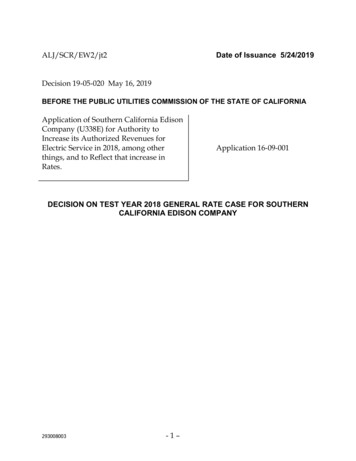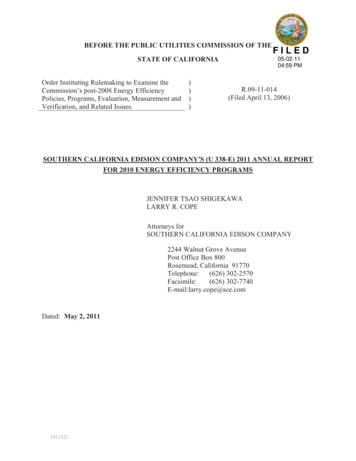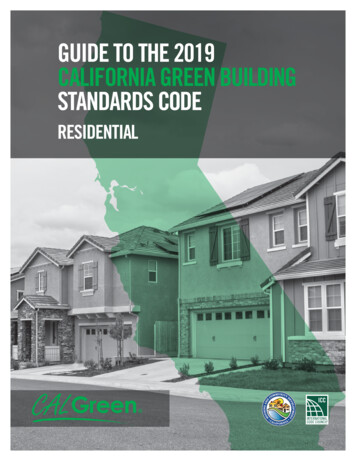
Transcription
GUIDE TO THE 2019CALIFORNIA GREEN BUILDINGSTANDARDS CODERESIDENTIALi
Guide to the 2019 California Green Building Standards Code(Residential)ISBN: 978-1-60983-935-2Project Manager: Richard WeinertPublications Manager:Anne KerrEditor: Phil ArviaTypesetting/Interior Design:Sue BrockmanCover Art Design:Julia LangeCOPYRIGHT 2019byDepartment of Housing and Community DevelopmentDivision of Codes and Standards9342 Tech Center Drive, Suite 500Sacramento, CA 95826andInternational Code Council500 New Jersey Avenue, NW, 6th FloorWashington, DC 20001ALL RIGHTS RESERVED. This is an educational publication by the Department of Housing and CommunityDevelopment (HCD) and a copyrighted work owned by the HCD and the International Code Council, Inc. (ICC).Without advance written permission from the copyright owners, no part of this book may be reproduced, distributed or transmitted in any form or by any means, including, without limitation, electronic, optical or mechanicalmeans (by way of example, and not limitation, photocopying or recording by or in an information storage retrievalsystem). For information on use rights and permissions, please contact: ICC Publications, 4051 FlossmoorRoad, Country Club Hills, IL 60478. Phone 1-888-ICC-SAFE (422-7233); or Department of Housing and Community Development Division of Codes and Standards, 9342 Tech Center Drive, Suite 500, Sacramento, CA95826. Phone 1-916-445-9471The information contained in this document is believed to be accurate; however, it is being provided for informational purposes only and is intended for use only as a guide. Publication of this document by the ICC should notbe construed as the ICC engaging in or rendering engineering, legal or other professional services. Use of theinformation contained in this workbook should not be considered by the user to be a substitute for the advice ofa registered professional engineer, attorney or other professional. If such advice is required, it should be soughtthrough the services of a registered professional engineer, licensed attorney or other professional.Trademarks: “International Code Council,” the “International Code Council” logo, “ICC,” the “ICC” logo, “International Green Construction Code,” “IgCC” and other names and trademarks appearing in this book are registeredtrademarks of the International Code Council, Inc., and/or its licensors (as applicable), and may not be usedwithout permission.The “CALGreen” logo is trademarked by CBSC.Errata on various ICC publications may be available at www.iccsafe.org/errataFirst Printing: October 2019PRINTED IN THE USAT024503
Guide to the 2019 California Green Building Standards Code (Residential)Table of ContentsAbbreviations and Acronyms . . . . . . . . . . . . . . . . . . . . . . . . . . . . . . . . . . . . . . . . . . . . . . . . . . viiContact and Purchasing Information . . . . . . . . . . . . . . . . . . . . . . . . . . . . . . . . . . . . . . . . . . . . . ixPreface . . . . . . . . . . . . . . . . . . . . . . . . . . . . . . . . . . . . . . . . . . . . . . . . . . . . . . . . . . . . . . . . . . . xChapter 1. ADMINISTRATION . . . . . . . . . . . . . . . . . . . . . . . . . . . . . . . . . . . . . . . . . . . . . . . . 1Administration. . . . . . . . . . . . . . . . . . . . . . . . . . . . . . . . . . . . . . . . . . . . . . . . . . . . . . . . . . . . 1Title . . . . . . . . . . . . . . . . . . . . . . . . . . . . . . . . . . . . . . . . . . . . . . . . . . . . . . . . . . . . . . . . . . . 1Purpose . . . . . . . . . . . . . . . . . . . . . . . . . . . . . . . . . . . . . . . . . . . . . . . . . . . . . . . . . . . . . . . . 1Application . . . . . . . . . . . . . . . . . . . . . . . . . . . . . . . . . . . . . . . . . . . . . . . . . . . . . . . . . . . . . . 2Scope . . . . . . . . . . . . . . . . . . . . . . . . . . . . . . . . . . . . . . . . . . . . . . . . . . . . . . . . . . . . . . . . . 2Use of Appendices . . . . . . . . . . . . . . . . . . . . . . . . . . . . . . . . . . . . . . . . . . . . . . . . . . . . . . . . 2Referenced Codes and Standards . . . . . . . . . . . . . . . . . . . . . . . . . . . . . . . . . . . . . . . . . . . 2Order of Precedence and Use . . . . . . . . . . . . . . . . . . . . . . . . . . . . . . . . . . . . . . . . . . . . . . . 3Local Amendments . . . . . . . . . . . . . . . . . . . . . . . . . . . . . . . . . . . . . . . . . . . . . . . . . . . . . . . 3Alternate Materials, Designs and Methods of Construction . . . . . . . . . . . . . . . . . . . . . . . . . 4Effective Use of the Code . . . . . . . . . . . . . . . . . . . . . . . . . . . . . . . . . . . . . . . . . . . . . . . . . . . 4Construction Documents and Installation Verification . . . . . . . . . . . . . . . . . . . . . . . . . . . . . 4Frequently Asked Questions. . . . . . . . . . . . . . . . . . . . . . . . . . . . . . . . . . . . . . . . . . . . . . . . . 5Chapter 2. DEFINITIONS. . . . . . . . . . . . . . . . . . . . . . . . . . . . . . . . . . . . . . . . . . . . . . . . . . . . . 9Chapter 3. GREEN BUILDING . . . . . . . . . . . . . . . . . . . . . . . . . . . . . . . . . . . . . . . . . . . . . . . 11Scope . . . . . . . . . . . . . . . . . . . . . . . . . . . . . . . . . . . . . . . . . . . . . . . . . . . . . . . . . . . . . . . . 11Mixed Occupancy Buildings . . . . . . . . . . . . . . . . . . . . . . . . . . . . . . . . . . . . . . . . . . . . . . . 12Phased Projects . . . . . . . . . . . . . . . . . . . . . . . . . . . . . . . . . . . . . . . . . . . . . . . . . . . . . . . . 12Voluntary Tiers . . . . . . . . . . . . . . . . . . . . . . . . . . . . . . . . . . . . . . . . . . . . . . . . . . . . . . . . . . 12Chapter 4. RESIDENTIAL MANDATORY MEASURES . . . . . . . . . . . . . . . . . . . . . . . . . . . 13Division 4.1 – Planning and Design . . . . . . . . . . . . . . . . . . . . . . . . . . . . . . . . . . . . . . . . . . 13Section 4.106 Site Development . . . . . . . . . . . . . . . . . . . . . . . . . . . . . . . . . . . . . . . . . . . 13Frequently Asked Questions . . . . . . . . . . . . . . . . . . . . . . . . . . . . . . . . . . . . . . . . . . . . . . . 16Section 4.106.4. Electric Vehicle (EV) Charging for New Construction. . . . . . . . . . . . . . 17Section 4.106.4.1 New One- and Two-Family Dwellings and Townhouseswith Attached Private Garages . . . . . . . . . . . . . . . . . . . . . . . . . . . . . . . . . . . . . . . . . . . 21iii
Section 4.106.4.2 New Multifamily Dwellings. . . . . . . . . . . . . . . . . . . . . . . . . . . . . . . . . . 23Frequently Asked Questions . . . . . . . . . . . . . . . . . . . . . . . . . . . . . . . . . . . . . . . . . . . . . . . 32Section 4.106.4.3 New Hotels and Motels. . . . . . . . . . . . . . . . . . . . . . . . . . . . . . . . . . . . 33Division 4.2 – Energy Efficiency . . . . . . . . . . . . . . . . . . . . . . . . . . . . . . . . . . . . . . . . . . . . 35Section 4.201 General . . . . . . . . . . . . . . . . . . . . . . . . . . . . . . . . . . . . . . . . . . . . . . . . . . 35Division 4.3 – Water Efficiency and Conservation . . . . . . . . . . . . . . . . . . . . . . . . . . . . . . . 36Section 4.303 Indoor Water Use . . . . . . . . . . . . . . . . . . . . . . . . . . . . . . . . . . . . . . . . . . . 36Section 4.304 Outdoor Water Use . . . . . . . . . . . . . . . . . . . . . . . . . . . . . . . . . . . . . . . . . . 42Frequently Asked Questions . . . . . . . . . . . . . . . . . . . . . . . . . . . . . . . . . . . . . . . . . . . . . . . 45Division 4.4 – Material Conservation and Resource Efficiency. . . . . . . . . . . . . . . . . . . . . . 46Section 4.406 Enhanced Durability and Reduced Maintenance . . . . . . . . . . . . . . . . . . 46Section 4.408 Construction Waste Reduction,Disposal and Recycling . . . . . . . . . . . . . . . . . . . . . . . . . . . . . . . . . . . . . . . . . . . . . . . . 47Section 4.410 Building Maintenance and Operation . . . . . . . . . . . . . . . . . . . . . . . . . . . 52Frequently Asked Questions . . . . . . . . . . . . . . . . . . . . . . . . . . . . . . . . . . . . . . . . . . . . . . 55Division 4.5 – Environmental Quality . . . . . . . . . . . . . . . . . . . . . . . . . . . . . . . . . . . . . . . . . 57Section 4.503 Fireplaces . . . . . . . . . . . . . . . . . . . . . . . . . . . . . . . . . . . . . . . . . . . . . . . . 57Section 4.504 Pollutant Control . . . . . . . . . . . . . . . . . . . . . . . . . . . . . . . . . . . . . . . . . . . 58Table 4.504.1 Adhesive VOC Limit . . . . . . . . . . . . . . . . . . . . . . . . . . . . . . . . . . . . . . . 59Table 4.504.2 Sealant VOC Limit . . . . . . . . . . . . . . . . . . . . . . . . . . . . . . . . . . . . . . . . . 60Table 4.504.3 VOC Content Limits for Architectural Coatings . . . . . . . . . . . . . . . . . . . 63Section 4.504.4 Resilient Flooring Systems . . . . . . . . . . . . . . . . . . . . . . . . . . . . . . . . . 64Table 4.504.5 Formaldehyde Limits. . . . . . . . . . . . . . . . . . . . . . . . . . . . . . . . . . . . . . . 66Section 4.505 Interior Moisture Control . . . . . . . . . . . . . . . . . . . . . . . . . . . . . . . . . . . . . . . 68Section 4.506 Indoor Air Quality and Exhaust . . . . . . . . . . . . . . . . . . . . . . . . . . . . . . . . . . 70Section 4.507 Environmental Comfort . . . . . . . . . . . . . . . . . . . . . . . . . . . . . . . . . . . . . . . . 71Frequently Asked Questions . . . . . . . . . . . . . . . . . . . . . . . . . . . . . . . . . . . . . . . . . . . . . . . 73Chapter 5. NONRESIDENTIAL MANDATORY MEASURES . . . . . . . . . . . . . . . . . . . . . . . 79Division 5.2 – Energy Efficiency . . . . . . . . . . . . . . . . . . . . . . . . . . . . . . . . . . . . . . . . . . . . . 80Section 5.201 General . . . . . . . . . . . . . . . . . . . . . . . . . . . . . . . . . . . . . . . . . . . . . . . . . . . . 80Chapter 6. REFERENCED ORGANIZATIONS AND STANDARDS. . . . . . . . . . . . . . . . . . 81Chapter 7. INSTALLER AND SPECIAL INSPECTOR QUALIFICATIONS (FORRESIDENTIAL PROJECTS) . . . . . . . . . . . . . . . . . . . . . . . . . . . . . . . . . . . . . . . . 83Section 702 Qualifications . . . . . . . . . . . . . . . . . . . . . . . . . . . . . . . . . . . . . . . . . . . . . . . . . 83iv
Guide to the 2019 California Green Building Standards Code (Residential)Section 703 Verifications . . . . . . . . . . . . . . . . . . . . . . . . . . . . . . . . . . . . . . . . . . . . . . . . . . 85Frequently Asked Questions . . . . . . . . . . . . . . . . . . . . . . . . . . . . . . . . . . . . . . . . . . . . . . . 86Chapter 8. COMPLIANCE FORMS, WORKSHEETS AND REFERENCE MATERIAL . . 87Appendix A4. RESIDENTIAL VOLUNTARY MEASURES . . . . . . . . . . . . . . . . . . . . . . . . . 89Division A4.1 – Planning and Design . . . . . . . . . . . . . . . . . . . . . . . . . . . . . . . . . . . . . . . . . 90Section A4.103 Site Selection . . . . . . . . . . . . . . . . . . . . . . . . . . . . . . . . . . . . . . . . . . . . 90Section A4.104 Site Preservation . . . . . . . . . . . . . . . . . . . . . . . . . . . . . . . . . . . . . . . . . . 92Section A4.106 Site Development . . . . . . . . . . . . . . . . . . . . . . . . . . . . . . . . . . . . . . . . . . 93Section A4.106.5 Cool Roof for Reduction of Heat Island Effect . . . . . . . . . . . . . . . . . . 96Cool Roof Tables . . . . . . . . . . . . . . . . . . . . . . . . . . . . . . . . . . . . . . . . . . . . . . . . . . . . . 97Section A4.106.8 Electric Vehicle (EV) Charging for New Construction . . . . . . . . . . . . 102Section A4.106.10 Light Pollution Reduction. . . . . . . . . . . . . . . . . . . . . . . . . . . . . . . . . 106Table A4.106.10 Maximum Allowable Backlight,Uplight and Glare (BUG) Ratings . . . . . . . . . . . . . . . . . . . . . . . . . . . . . . . . . . . . . . . . 106Section A4.108 Innovative Concepts and Local EnvironmentalConditions . . . . . . . . . . . . . . . . . . . . . . . . . . . . . . . . . . . . . . . . . . . . . . . . . . . . . . . . . 107Division A4.2 – Energy Efficiency . . . . . . . . . . . . . . . . . . . . . . . . . . . . . . . . . . . . . . . . . . 108Section A4.201 General . . . . . . . . . . . . . . . . . . . . . . . . . . . . . . . . . . . . . . . . . . . . . . . . . 108Division A4.3 – Water Efficiency and Conservation . . . . . . . . . . . . . . . . . . . . . . . . . . . . . 109Section A4.303 Indoor Water Use . . . . . . . . . . . . . . . . . . . . . . . . . . . . . . . . . . . . . . . . . 110Section A4.304 Outdoor Water Use . . . . . . . . . . . . . . . . . . . . . . . . . . . . . . . . . . . . . . . 115Section A4.305 Water Reuse Systems . . . . . . . . . . . . . . . . . . . . . . . . . . . . . . . . . . . . . 117Division A4.4 – Material Conservation and Resource Efficiency . . . . . . . . . . . . . . . . . . . 119Section A4.403 Foundation Systems . . . . . . . . . . . . . . . . . . . . . . . . . . . . . . . . . . . . . . 119Section A4.405 Material Sources . . . . . . . . . . . . . . . . . . . . . . . . . . . . . . . . . . . . . . . . . 121Section A4.408 Construction Waste Reduction, Disposal and Recycling. . . . . . . . . . . 128Division A4.5 – Environmental Quality . . . . . . . . . . . . . . . . . . . . . . . . . . . . . . . . . . . . . . . 130Section A4.504 Pollutant Control . . . . . . . . . . . . . . . . . . . . . . . . . . . . . . . . . . . . . . . . . 130Section A4.506 Indoor Air Quality and Exhaust. . . . . . . . . . . . . . . . . . . . . . . . . . . . . . . 134Division A4.6 – Tier 1 and Tier 2 . . . . . . . . . . . . . . . . . . . . . . . . . . . . . . . . . . . . . . . . . . . 136Section A4.601 General . . . . . . . . . . . . . . . . . . . . . . . . . . . . . . . . . . . . . . . . . . . . . . . . . 136Tier 1 Requirements . . . . . . . . . . . . . . . . . . . . . . . . . . . . . . . . . . . . . . . . . . . . . . . . . . . 138Tier 2 Requirements . . . . . . . . . . . . . . . . . . . . . . . . . . . . . . . . . . . . . . . . . . . . . . . . . . . 139Residential Occupancies Application Checklist . . . . . . . . . . . . . . . . . . . . . . . . . . . . . . 140v
Sample Residential Occupancies Application Checklist . . . . . . . . . . . . . . . . . . . . . . . . 142Frequently Asked Questions . . . . . . . . . . . . . . . . . . . . . . . . . . . . . . . . . . . . . . . . . . . . . 143Division A4.7 – Residential Model Ordinance . . . . . . . . . . . . . . . . . . . . . . . . . . . . . . . . . 144Appendix A5. NONRESIDENTIAL VOLUNTARY MEASURES . . . . . . . . . . . . . . . . . . . . 145Division A5.2 – Energy Efficiency . . . . . . . . . . . . . . . . . . . . . . . . . . . . . . . . . . . . . . . . . . . 146Section A5.201 General. . . . . . . . . . . . . . . . . . . . . . . . . . . . . . . . . . . . . . . . . . . . . . . . . 146vi
Guide to the 2019 California Green Building Standards Code (Residential)ABBREVIATIONS AND ACRONYMS(This list is provided for user convenience. Terms defined or explained further in CALGreen andin this guide are not included in this list.)ABAssembly Bill (legislation) followed by a number; approved bills oftenfollowed by a Chapter (Ch.) number and year of statutes (Stat.)ACCAAir Conditioning Contractors of AmericaACMAlternative Calculation Method as used by the California EnergyCommissionANSIAmerican National Standards InstituteARB/CARBCalifornia Air Resources BoardASMEAmerican Society of Mechanical EngineersASHRAEAmerican Society of Heating, Refrigerating andAir-Conditioning EngineersASTMAmerican Society for Testing and MaterialsBSC-CG-CBSCCalifornia Building Standards Commission, CALGreenCalifornia Climate ZonesShown on California Energy Commission Climate Zone MapCALGreenCalifornia Green Building Standards CodeCal/EPACalifornia Environmental Protection AgencyCalRecycleCalifornia Department of Resources Recycling and Recovery(formerly California Integrated Waste Management Board andDepartment of Conservation)CBCCalifornia Building Code (CCR, Title 24, Part 2)CCRCalifornia Code of Regulations (includes Title 24, the CaliforniaBuilding Standards Code)C&DConstruction and demolition as used for construction wasteCEC*California Energy Resources Conservation and DevelopmentCommission (aka California Energy Commission);*Also refers to California Energy Code (CCR, Title 24, Part 6)CRCCalifornia Residential Code (CCR, Title 24, Part 2.5)CWMPConstruction Waste Management PlanDWRDepartment of Water Resourcesvii
ABBREVIATIONS AND ACRONYMS (continued)(This list is provided for user convenience. Terms defined or explained further in CALGreen andin this guide are not included in this list.)viiiEPAU.S. Environmental Protection AgencyGPM/gpmGallons per minute related to liquid flowHCDCalifornia Department of Housing and Community DevelopmentHERSHome Energy Rating System Program (administered by the California Energy Commission)HR or [HR]HCD “banner” designating provisions applicable for high-rise residential buildings.HVACHeating, ventilating and air conditioningMWELOModel Water Efficient Landscape Ordinance, located in the California Code of Regulations, Title 23, Division 2, Chapter 2.7.NSFNSF International (formerly National Sanitation Foundation)PSI/psiPounds per square inch as related to pressureSBSenate Bill (legislation) followed by a number; approved bills oftenfollowed by a Chapter (Ch.) number and year of statutes (Stat.)SCAQMDSouth Coast Air Quality Management DistrictSWRCBState Water Resources Control BoardTITLE 17Public Health regulations in the California Code of Regulations(CCR)TITLE 20Public Utilities and Energy regulations in the California Code ofRegulations (CCR)TITLE 23The Department of Water Resources (DWR) regulations in the California Code of Regulations (CCR), located in Division 2.TITLE 24California Building Standards Code, as included in the CaliforniaCode of Regulations (CCR)VOCVolatile organic compounds as defined in CALGreen, Chapter 2
Guide to the 2019 California Green Building Standards Code (Residential)CONTACT AND PURCHASING INFORMATIONCalifornia Green Building Standards for Residential BuildingsCalifornia Department of Housing and Community DevelopmentDivision of Codes and StandardsState Housing Law Program9342 Tech Center Drive, Suite 500Sacramento, CA 95826-2582Telephone:(800) 952-8356Fax:(916) 854-2551Website:www.hcd.ca.govQuestions:See “Questions, Comments, Feedback” on website. Use“Leave Us a Comment” form.California Residential Energy Efficiency StandardsCalifornia Energy Efficiency HotlineTelephone:(916) 654-5106; 1-800-772-3300 (toll free in CA)E-mail:title24@energy.state.ca.usCalifornia Green Building Standards for Nonresidential BuildingsCalifornia Building Standards Commission2525 Natomas Park Drive, Suite 130Sacramento, CA 95833Telephone:(916) 263-0916Fax:(916) ca.govPurchasing Information for “Guide to the 2019 California GreenBuilding Standards Code – Residential” and the 2019 CALGreen(loose-leaf or eCode)International Code Council3060 Saturn Street, Suite 100Brea, CA 92821Telephone:1-888-ICC-SAFE (422-7233)Order Toll-free: e.orgE-mail:order@iccsafe.orgix
PrefaceThe Division of Codes and Standards in theDepartment of Housing and Community Development (HCD) is pleased to provide the followingdocument, Guide to the 2019 California GreenBuilding Standards Code – Residential. Thisguide includes selected text from the 2019 California Green Building Standards Code, known asCALGreen, which was developed from review andadoption of “carryover” 2016 CALGreen provisionsas well as new provisions and modifications basedon feedback and input from numerous stakeholders.The 2019 CALGreen Guide also addresses changesto the 2016 CALGreen from the 2016 InterveningCode Adoption Cycle. The 2019 CALGreen becomeseffective on January 1, 2020.This guide was developed by HCD to supplementour core publication, A Guide to California HousingConstruction Codes. The 2019 CALGreenGuide provides commentary, background,questions and answers and some helpfultools for the code user to better understand the mandatory and voluntarymeasures developed by HCD for residential structures. It is intended toprovide additional guidance andfurther enhance user awareness and understanding.Increased awareness ofstate laws, regulations,and building standards will improvecompliance andreduce housingconstructioncosts anddelays.x
Guide to the 2019 California Green Building Standards Code (Residential)HCD encourages homeowners, design and industry professionals and building departmentpersonnel involved in the construction, maintenance, and use of residential buildings to readthis guide as a complement to the mandatory measures and enhanced voluntary tiers in the2019 CALGreen. Further, users of the 2019 Guide to the California Green Building StandardsCode – Residential should always utilize the most current version of CALGreen, including amendments from the Intervening Code Adoption Cycle, emergency regulations, other supplements orERRATA that are published for that specific edition of the code. Users should also check for anylocal amendments applicable to structures for specific jurisdictions.Note: Readers new to California laws, regulations, building standards development or HCD’s rolemay find it beneficial to read A Guide to California Housing Construction Codes, available at http://www.hcd.ca.gov/.AcknowledgementsHCD appreciates and acknowledges the time, effort and technical expertise so many participantsprovided during the initial development and subsequent versions of CALGreen. Participants werecomprised of other state agencies, model code organizations, building officials, the constructionindustry, the environmental community and green building industry.HCD expresses special thanks to the California Building Industry Association, which providedadditional assistance, time and resources to facilitate timely completion of the first edition in June2010.Introduction to CALGreenCALGreen is California’s first green building code and a first-in-the-nation state-mandated greenbuilding code. It is formally known as the California Green Building Standards Code, Title 24, Part11, of the California Code of Regulations.This guide will provide helpful tools and information about CALGreen’s mandatory measures,voluntary tiers, and other regulations, laws and construction codes related to green building standards, which are applicable to residential construction in California. It is recommended that thereader be familiar with California building standards development, adoption and implementation processes as discussed in HCD’s A Guide to California Housing Construction Codes, whichprovides general information on California building codes. It is also recommended that the readerhave the current edition of CALGreen for reference while reading this guide.It is important that code users reference the appropriate version of CALGreen, including anyerrata or supplements from emergency or intervening code adoption cycles. Additionally, codeusers should be aware of lawfully enacted local amendments such as ordinances or resolutionsrequiring additional and/or more restrictive green building ebsiteatwww.hcd.ca.gov or on the California Building Standards Commission’s website atwww.dgs.ca.gov/bsc. It is also available for purchase from the International Code Council(www.iccsafe.org).xi
BackgroundDevelopment of California green building standards was originally approached from a legislativeor statutory approach. Several Assembly Bills (AB 35, AB 888, and AB 1058) were introducedduring the 2007–2008 legislative session to require green building standards for state-ownedor leased buildings, commercial buildings, and residential buildings, respectively. Although thebroad intent for implementing green building measures was supported by the Governor’s Office,after much consideration, these bills were ultimately vetoed. Governor Arnold Schwarzenegger’sveto message stated: Building standards should not be statutory. The California Building Standards Commission(BSC) was created to ensure an open public adoption process allowing experts to developbuilding standards, including periodic updates to the building codes. Allowing private entities to dictate California’s building standards usurps the state’s authorityto develop and adopt those standards and could compromise the health and safety of Californians. State agencies were encouraged to review all nationally recognized programs and gleanfrom those programs, standards that promote greener construction, energy and waterconservation, and reduce greenhouse gas emissions. The need to expedite the greening of California’s building standards was emphasized andBSC was directed to work with specified state agencies on the adoption of green buildingstandards for residential, commercial, and public building construction for the 2010 codeadoption process.Development of CALGreen began in 2007 when the BSC Commissioners directed its staff todevelop green building standards for new construction of buildings within its authority and tosubmit those regulations for adoption during the 2007 Annual Code Adoption Cycle. The Commissioners also requested and encouraged HCD, the Division of the State Architect (DSA), and theOffice of Statewide Health Planning and Development (OSHPD) to develop green building standards for new buildings under their areas of authority. Through the rulemaking process, HCDcollaborated with BSC, stakeholder groups, other state agencies, considered public input andreviewed existing green building standards, best practices, guidelines and other published references. This initial effort was successful and resulted in BSC’s adoption of the 2008 CaliforniaGreen Building Standards Code.Introduction of the 2008 California Green Building Standards Code was supplemented by clarifying information that local enforcing agencies have the option to adopt local amendments or evenadopt the 2008 California Green Building Standards Code prior to its effective date (see BSCBuilding Standards Bulletin 08-02). It was acknowledged that the initial 2008 California GreenBuilding Standards Code would provide a framework and first step toward establishing mandatorygreen building standards for residential structures and would be enhanced and/or expanded in thefuture. This vision came to fruition during the Triennial Code Adoption Cycle for the 2010 CaliforniaBuilding Standards Codes.As new materials, technology, and designs are developed and become available, and as needsbecome apparent, CALGreen will continue to proactively move California forward to a moresustainable and environmentally responsible future.xii
Guide to the 2019 California Green Building Standards Code (Residential)2013 California Green Building Standards Code (CALGreen)The 2010 CALGreen was evaluated for updates during the 2012 Triennial Code Adoption Cycle.HCD evaluated stakeholder input, changes in technology, implementation of sustainable buildinggoals in California, and changes in statutory requirements. As such, the scope of CALGreen wasincreased to include both low-rise and high-rise residential structures, additions and alterations.The 2012 Triennial Code Adoption Cycle also involved the California Energy Commission as anactive participant and proposing agency in development of green building standards. The BSCadopted and approved HCD’s proposed changes and existing 2010 amendments (as broughtforward from the 2010 CALGreen) during its regular business meeting on December 11, 2012.During the 2012 Triennial Code Adoption Cycle, HCD also placed “pointers” in various parts ofTitle 24 to direct code users to CALGreen. This was done for several reasons:1) To familiarize code users with the requirements of CALGreen;2) To refer code users to relevant provisions contained in CALGreen; and3) To locate appropriate sections in other parts of Title 24 for consistency.2013 CALGreen Emergency RegulationsGovernor Edmund “Jerry” Brown’s Executive Order B-29-15 (April 1, 2015) provided a summaryof the ongoing drought conditions in California starting with declarations for a State of Emergency(January 17, 2014) and Continued State of Emergency (April 25, 2014); evidence of a recordlow snowpack, decreased water levels in reservoirs, reduced river flows, and declining suppliesin underground water basins. In addition, the Governor acknowledged that a distinct possibilityexisted for drought conditions to continue. Further, the Executive Order found that conditions ofextreme peril to the safety of persons and property continue to exist due to water shortage anddrought conditions with which local authority is unable to cope. To address these concerns, theExecutive Order specified that strict compliance with identified statutes and regulations wouldprevent, hinder, delay or mitigate the effects of the drought. In view of the urgency to conserveCalifornia’s water resources, as deemed essential by the Governor’s Executive Order and priorproclamations, HCD proposed the adoption of these building standards through an emergencyadoption process.The 2015 emergency regulatory action made critically needed changes to the 2013 CALGreen,Sections 4.303, 4.304, and A4.304, as related to reduction of indoor and outdoor residentialpotable water use. These emergengy regulations were approved as permanent regulations in the2013 CALGreen, effective January 26, 2016.xiii
2013 CALGreen Intervening Code Adoption CycleHCD brought forward the voluntary Electric Vehicle (EV) provisions as new mandatory EV requirements in the 2013 Intervening Code Adoption Cycle. The new mandatory requirements wereapplicable to one- and two-family and townhouses with attached private garages. HCD also addednew requirements for new multifamily projects with 17 or more dwellings.New one- and two-family dwellings and townhouse with attached private garages were requiredto have sufficient space and capacity to accommodat
CBC California Building Code (CCR, Title 24, Part 2) CCR California Code of Regulations (includes Title 24, the California Building Standards Code) . to the 2016 CALGreen from the 2016 Intervening Code Adoption C



